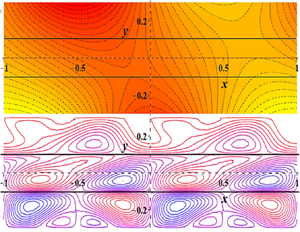Published online by Cambridge University Press: 06 December 2023

In microfluidic systems, analyte/reagent mixing is essential to achieve rapid chemical/biochemical reactions. The low Reynolds number (Re) flow, however, makes passive mixing difficult and necessitates the use of some external stimulus to cause disturbance in the system. Here, we report how a periodic thermocapillary effect may interact with strategically patterned wall wettability and boost the mixing dynamics in a micro-confined ternary-liquid film system. Approximate, yet without compromise on the physics involved, analytical solutions to the energy and Navier–Stokes equations under creeping flow conditions are obtained to comprehend the thermal and hydrodynamic characteristics of the thermo-capillarity. In the binary fluid limit, our model is validated with the findings of Pendse & Esmaeeli (Intl J. Therm. Sci., vol. 49, 2010, pp. 1147–1155), and good agreement is found. The flow characteristics in the ternary-liquid system due to discrete wall temperatures is also demonstrated via finite-element-based numerical simulations, and agreement with the semi-analytical solution is noted. The qualitative study of the flow pattern reveals that enhanced mixing is obtained as a result of vortical motion created by the interplay of the periodic thermo-capillarity-driven interfacial flow and wall slip. The observation is further consolidated from the numerical simulation of the species transport equation. The species distribution so obtained is compared with fully developed laminar flow for the same inlet concentration. Our study further investigates the effects of the fluids’ relative thermal conductivity, wall slip length, relative film thickness and thermal (or slip) phase differences on the mixing efficiency of the proposed arrangement. While wall slip, relative film thickness and relative thermal conductivity regulate mixing in the top and bottom layers, phase difference determines how well the middle fluid layer mixes. Slip at the walls creates vortex distortions to get a strong churning effect. The lower thermal conductivity of the top and bottom fluids weakens the thermocapillary flow; however, the dominance of the patterned slip improves mixing in such cases.